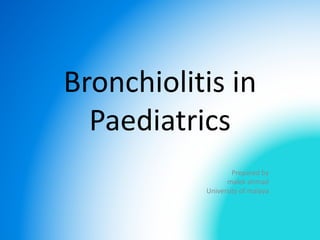
bronchiolitis in paediatrics
- 1. Bronchiolitis in Paediatrics Prepared by malek ahmad University of malaya
- 3. Introduction Acute infectious inflammatory disease of the URT and LRT that result in obstruction of the small airways Occur in all age gp, larger airways of older children and adults better accommodate mucosal edema, severe respiratory symptoms limited to young infants 90% are aged 1-9 months (rare after 1 year of age), boys affected more than girls Major concern not only the acute effects bronchiolitis but the possible development of chronic airway hyperreactivity (asthma) Infants a affected most often because of their small airways, high closing volumes, and insufficient collateral ventilation
- 5. Aetiological agents • Isolated agent in 75% of children younger than 2 years and highly contagious • Enveloped RNA virus that belongs to the Paramyxoviridae family within the Pneumovirus genus • Two RSV subtypes A (severe) and B (structural variations in the G protein) • Viral shedding in nasal secretions for 6-21 days after symptoms develop. IP =2-5 days • Complex immunologic mechanisms play a role in RSV bronchiolitis. Type I allergic reactions mediated by the IgE antibody account for significant bronchiolitis thus breastfed babies (colostrum-IgA) relatively protected Respiratory Syncytial Virus (RSV) Human metapneumovirus, parainfleunze, influenza, rhinovirus, adenovirus • accounts for 5-15% particularly among older children and adults Mycoplasma pneumoniae
- 6. Risk factors Low birth weight (PREM) Lower socioeconomic gp Parental smoking Crowded condition, daycare Chronic lung disease- bronchopulmonary dysplasia CHD + pulmonary hypertension <3 months old Aiways anomalies Congenital/ acquired immunedeficiency disease
- 7. Pathophysiology Acquisition of infection Necrosis of respiratory epithelium (<24h) Proliferation of goblet cells > excessive mucus production Nonciliated epithelium cell regeneration > impaired secretion elimination (removed by macrophages) Lymphocytic infiltration > submucosal edema Cytokine and chemokines released > Increased cellular recruitment Obstruction due to inflammatory cells debris + fibrin + mucus + edema fluid (not due to bronchoconstriction) Bronchioles obstruction lead to hyperinflation + increase airways resistance + atelactasis + V/Q mismatch Recovery with bronchiolar epithelium regeneration after 3-4 days
- 8. Clinical presentation History Coryza – rhinorrhea, fever Dry cough Progressive breathlessness Wheezing Feeding difficulty Hypothermic (<1 month) Respiratory distress- tachypnea, nasal flare, recession, irritability and cyanosis Physical Sharp and dry cough Tachypnoea and tachycardia Recession Hyperinflated chest – sternum prominent + liver displaced Fine end inspiratory crackles High pitched wheezes- expiratory > inspiratory Cyanosis / pallor
- 11. Investitigation • Lymphocytosis FBC • To detect RSA antigen in epithelial cell from secretion • Direct immunofluorescent antibody (IFA) staining or ELISA, PCR Nasopharyngeal swab/ nasal wash • Hyperinflated lung due to airways obstruction, air trapping and focal atelectasis (arterial desaturation) • Increased interstitial marking and peribronchiol cuffing Chest Xray • In severe cases show lowered arterial oxygen and raised CO2 tensionBlood gas analysis • May display arrhythmias or cardiomegaly ECG, ECHO
- 12. A chest radiography revealing lung hyperinflation with a flattened diaphragm and bilateral atelectasis in the right apical and left basal regions in a 16- day-old infant with severe bronchiolitis
- 13. Management Supportive (viral) provide adequate fluid (NG/IV) to maintain hydration and monitor for apnea (infant) Humidified O2 delivered via nasl cannulae determined by pulse oximetry Mist/ antibiotics/ steroids not helpful Nebulised bronchodilator (salbutamol/ipratropium) often used but not reduce severity / illness duration Prophylaxis- good hand hygiene and monoclonal antibody prophylaxis (im palivizumab) Prognosis Recover with 2w Half will have recurrent cough + wheeze Following adenovirus infection > permanent airways damage (bronchiolitis obliterans)
- 14. Bronchitis (whooping cough / pertussis) •Inflammation of brochi produce mixture of wheeze and coarse crackles •Main symptoms: cough(<2w if >2w caused by pertussis/ mycoplasma) and fever •Complication: pneumonia, convulsion, bronchiectasis and death (infants with apnea) Highly infectious caused by bordetella pertussis •Catarrhal phase (1w): coryza •Paroxysmal phase (3-6w): paroxysmal/spasmodic cough then inspiratory whoop, cough worse at night + vomit, can go red/blue, mucus flow from nose and mouth, apnea (infant), epistaxis (nosebleed) and sunconjuctival haemorrhage •Convalescent phase (persist months): symptoms decrease Phases •Culture of nasal swab •FBC: marked lymphocytosis Investigation •Erythromycin for eradicates organism, closed contact and prophylaxis •Immunisation reduce risk developed pertussis but not 100% Treatment and management